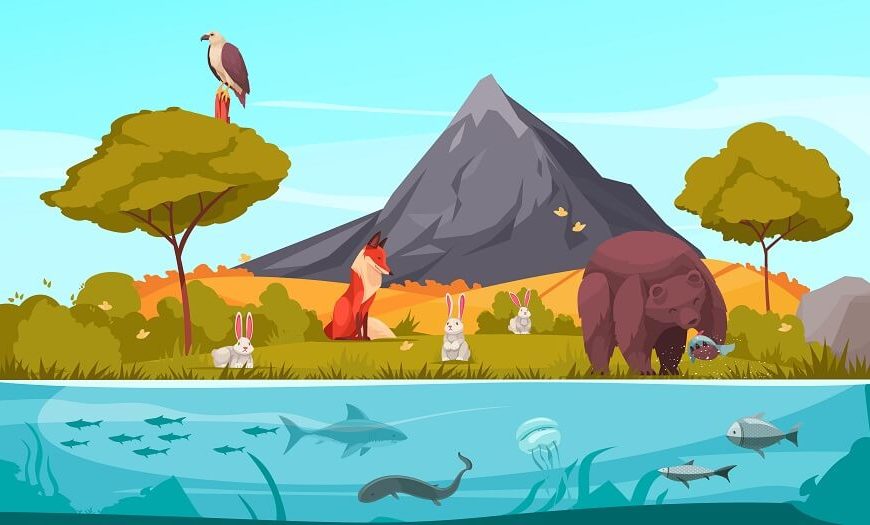An ecosystem is a community of living organisms (plants, animals, and microbes) interacting with their physical environment (air, water, and soil). It is a fascinating and complex system that plays a crucial role in sustaining life on our planet. While the word ecosystem is often associated with nature and the environment, its scope extends far beyond that. To fully grasp what an ecosystem is, it is essential to understand its structure, functions, types, and more. In this article, we will explore ecosystems in detail, breaking down their key components and significance.
What is an Ecosystem?
As mentioned before, an ecosystem encompasses a group of living things that is dynamic and interrelated. Ecosystems can vary greatly in size and type, from small ponds to vast forests and even urban areas.
Important Ecological Concepts
Food webs, food pyramids, and food chains are important concepts to understand the intricacies of our ecosystems.
- Food webs
- Food Chain
- Food Pyramid
Food webs describe the relations of different species in a community and how energy and other nutrients are transferred from one stage to another. It focuses on symbiotic relationships and sheds light on the various functions of species in the context of mutual interdependence.
A food chain is a linear sequence of organisms starting with producers, followed by consumers, comprising herbivores, carnivores, omnivores, and finally, organisms that decompose substances. One organism feeds on others, and the decomposers feed on the dead organism and release nutrients into the soil so the producers can generate food again.
The food pyramid, also known as the Trophic pyramid, is the fundamental structure of interaction within the biological community. Here, the food energy is transferred between organisms from one trophic level to the next through the food chain. These pyramids portray the energy, biomass or number of organisms as they convert from the primary producers to the higher levels of the food pyramid, pointing to the effectiveness and constraints that govern the energy transfer within the trophic levels.
The Structure of Ecosystem: 2 Essential Components
An ecosystem is made up of both living (biotic) and non-living (abiotic) components, which work together to maintain balance in nature. Its structure is defined by how these components are organised and how energy flows within the system. A specific area’s climate and environmental conditions also play a key role in shaping its ecosystem.
An ecosystem consists of two main components:
Biotic Components (Living organisms)
- Abiotic Components (Non-living elements)
- Biotic Components
- Producers
- Consumers
- Primary consumers: Herbivores that eat producers (e.g., deer, rabbits, grasshoppers).
- Secondary consumers: Carnivores or omnivores that eat primary consumers (e.g., frogs, snakes, foxes).
- Tertiary consumers: Organisms that eat secondary consumers (e.g., eagles, sharks, tigers).
- Quaternary consumers: Found in some food chains, these top predators feed on tertiary consumers (e.g., killer whales and lions).
These interconnected components form an open system where energy and nutrients move freely across boundaries.
These are the creatures that make up an ecosystem. They can be divided into three other groups:
Producers, like plants and algae, make their own food through photosynthesis. They use sunlight to convert carbon dioxide and water into energy. Since all other organisms rely on them for food, they form the foundation of the food chain.
Consumers are organisms that cannot produce their food and depend on others for energy. They are further classified into:
- Decomposers
- Abiotic Components
Decomposers like fungi and bacteria break down dead plants and animals. This process returns essential nutrients to the soil, making them available for plants to use again. Without decomposers, ecosystems would be overwhelmed with waste, and nutrient cycles would be disrupted.
Abiotic components are the non-living elements that shape an ecosystem. These include:
- Air: Provides oxygen for respiration and carbon dioxide for photosynthesis.
- Water: Essential for all living organisms and biochemical processes.
- Soil: Supports plant life and stores nutrients.
- Sunlight: Drives photosynthesis and regulates temperature.
- Temperature: Affects the survival and behaviour of organisms.
- Minerals and Nutrients: Needed for plant growth and energy transfer.
- Wind and Altitude: Influence climate and vegetation types.
- Turbidity: Determines water clarity, which affects aquatic life.
Together, these abiotic factors create the conditions in which ecosystems thrive.
11 Amazing Functions of An Ecosystem
In many respects, ecosystems are crucial to maintaining the condition of our Earth and preserving life. Among the crucial duties are:
- Nutrient Cycling: For living things to survive, ecosystems make sure that nutrients like carbon, nitrogen, and phosphorus are constantly moving around. Further, reports about ecosystem services highlight that healthy ecosystems contribute significantly to carbon sequestration, thus mitigating climate change.
- Climate Regulation: Controlling temperature, humidity, and air composition affects local and planetary climate patterns.
- Water Purification: Ecosystems purify Water naturally as it passes through soils and vegetation.
- Pollination: The pollination of plants, which results in the production of food, depends on several habitats.
- Recreation and Aesthetic Value: Ecosystems provide artistic expression, recreational activities, and cross-cultural understanding.
- Importance of Ecosystems: The value of ecosystems and the need to protect them must be understood to fully appreciate their significance.
- Biodiversity: Because they are the home to a broad range of species, ecosystems serve as hubs of biodiversity. Ecosystem resilience and flexibility to environmental changes are ensured through biodiversity.
- Economic Value: Resources like food, medicine, and raw materials that are necessary for human well-being and economic growth are provided by ecosystems.
- Cultural Significance: Many indigenous societies have strong spiritual and cultural links to particular ecologies that are fundamental to their identities and ways of life.
- Carbon Sequestration: Forest ecosystems are vital for storing carbon dioxide and preventing climate change.
- Natural Disaster Mitigation: Coastal ecosystems like mangroves and wetlands act as natural barriers against storms and tsunamis, reducing the consequences of natural disasters.
Discover Different Types of Ecosystems
Let us look at the wide variety of ecosystems that are present in our world now that we are aware of what they are, why they matter, and what makes them unique. Ecosystems may be categorised into several groupings based on a variety of elements, including their geographic location, dominating flora, and distinguishing characteristics. Some of the renowned ecosystem types include the following:
Planetary Ecosystems
- Ecosystems in forests
- Grassland Ecosystems
- Desert Ecosystems
- Tundra Ecosystems
Forest ecosystems, which are dominated by various tree species, are frequently found in regions with high rainfall. Boreal forests, tropical rainforests, temperate forests, and other types of forest ecosystems are among the numerous varieties. They are paramount to preserving biodiversity, sequestering carbon, and producing timber.
Large expanses of grass are a distinctive feature of these ecosystems, which are frequently seen in regions with irregular rainfall. The numerous forms of Grassland Ecosystems include savannas, prairies, and steppes. Agriculture, grazing animals, and carbon sequestration are all supported by grasslands.
Desert ecosystems are found in dry areas with little rainfall, little vegetation, and large temperature swings. Hot deserts, coastal deserts, cold deserts, and many more desert ecosystems exist. Unusual flora and animals that have developed to tolerate harsh conditions can be found in deserts.
The vegetation in tundra, which are extremely cold, treeless areas with permafrost, has adapted to the severe cold. The two distinct forms of tundra ecosystems are arctic and alpine tundra. They have a tremendous role to play in maintaining organisms that can withstand the cold as well as in regulating the temperature globally.
Aquatic Ecosystems
- Freshwater Ecosystems
- Marine Ecosystems
- Estuarine Ecosystems
- Intertidal Ecosystems
Freshwater ecosystems are crucial ecosystems in terms of their types. The lakes, ponds, rivers, and wetlands comprise these freshwater-dominated landscapes. The two primary forms of freshwater habitats are lentic (standing water) and lotic (flowing water). They provide access to drinking water, leisure activities, and refuge for aquatic life.
The marine ecosystems are a part of the oceans and seas, which cover more than 70% of the surface of the Earth. The many types of marine ecosystems include open oceans, kelp forests, coral reefs, and others. They support a wide range of marine life, provide oxygen, and regulate the planet’s climate.
Estuaries, which are places where freshwater rivers meet the sea, give rise to amazing ecosystems. They perform important ecological tasks, such as water filtration, and play significant roles in fish modification.
The areas around coasts known as intertidal zones are those that are exposed at low tide and buried during high tide. Numerous animal organisms that have come about to exist in abnormal environments use them as their home. These are the types of ecosystems and their types that are sustained in water bodies.
Specialised Ecosystems
- Urban Ecosystems
- Agricultural Ecosystems
- Mountain Ecosystems
Human activities, including highway construction, building construction, and environmental pollution, impact these urban ecosystems. A comprehension of urban ecosystems is a prerequisite for sustainable urban development and raising modern living standards.
Domesticated animals and cultivated plants prevail in these areas and serve as the primary providers of food and resources. For there to be enough food for everyone, agricultural output and environmental sustainability must be balanced.
Rugged terrain, high heights, and distinctive flora and fauna adapted to harsh environments are characteristics of mountain ecosystems. They facilitate access to fresh water, promote biodiversity, and serve as popular tourist destinations. These are the different types of ecosystems.
Functions of Ecosystem
An ecosystem performs several vital functions that help maintain balance in nature. These include:
- Regulating ecological processes: Ecosystems support life by maintaining essential processes like oxygen production, water purification, and climate regulation.
- Cycling of nutrients: Nutrients continuously move between living organisms (biotic components) and non-living elements (abiotic components).
- Maintaining trophic balance: The food chain ensures a stable relationship between producers, consumers, and decomposers.
- Recycling minerals: Essential minerals cycle through different parts of the biosphere to support life.
- Energy exchange: Abiotic factors like sunlight, water, and air help in the formation of organic compounds, driving energy flow within the ecosystem.
Conclusion
In conclusion, the ecosystem is more than just nature or the environment. It encompasses all living creatures, physical entities, and relationships between living and non-living entities. Understanding ecosystems’ structure, functions, and types helps us appreciate their role in supporting biodiversity and human survival. As parents, it’s your responsibility to teach your children about different types of ecosystems and ecosystem structure and function. Visit our blog, Preschoolers Go Wild: Outdoor Nature Activities For World Wildlife Day, for tips on planning fun outdoor activities to enhance your little one’s knowledge of nature and the ecosystem.
For informative and accurate articles on all things related to your newborn or toddler’s development, growth, health and nutrition, visit EuroKids Blogs and do check out our nationally recognised preschools– EuroKids Preschoolers for the first step in your kid’s educational journey!















